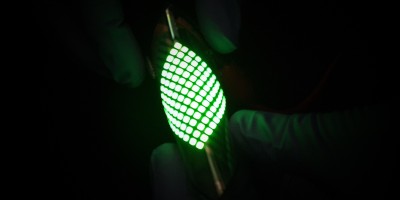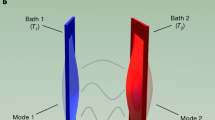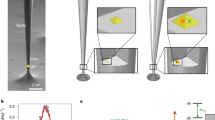Abstract
One of the fundamental predictions of quantum mechanics is the occurrence of random fluctuations in a vacuum caused by the zero-point energy. Remarkably, quantum electromagnetic fluctuations can induce a measurable force between neutral objects, known as the Casimir effect1, and it has been studied both theoretically2,3 and experimentally4,5,6,7,8,9. The Casimir effect can dominate the interaction between microstructures at small separations and is essential for micro- and nanotechnologies10,11. It has been utilized to realize nonlinear oscillation12, quantum trapping13, phonon transfer14,15 and dissipation dilution16. However, a non-reciprocal device based on quantum vacuum fluctuations remains an unexplored frontier. Here we report quantum-vacuum-mediated non-reciprocal energy transfer between two micromechanical oscillators. We parametrically modulate the Casimir interaction to realize a strong coupling between the two oscillators with different resonant frequencies. We engineer the system’s spectrum such that it possesses an exceptional point17,18,19,20 in the parameter space and explore the asymmetric topological structure in its vicinity. By dynamically changing the parameters near the exceptional point and utilizing the non-adiabaticity of the process, we achieve non-reciprocal energy transfer between the two oscillators with high contrast. Our work demonstrates a scheme that employs quantum vacuum fluctuations to regulate energy transfer at the nanoscale and may enable functional Casimir devices in the future.




Similar content being viewed by others
Data availability
The data for Figs. 2–4 and Extended Data Figs. 5 and 6 are provided as source data with this paper and on Zenodo (https://doi.org/10.5281/zenodo.5149270).
Code availability
The custom codes that support the findings of this study are available from the corresponding author upon reasonable request.
References
Casimir, H. B. G. On the attraction between two perfectly conducting plates. Proc. Kon. Ned. Akad. Wet. 51, 793–795 (1948).
Manjavacas, A. & García de Abajo, F. J. Vacuum friction in rotating particles. Phys. Rev. Lett. 105, 113601 (2010).
Woods, L. M. et al. Materials perspective on Casimir and van der Waals interactions. Rev. Mod. Phys. 88, 045003 (2016).
Lamoreaux, S. K. Demonstration of the Casimir force in the 0.6 to 6 μm range. Phys. Rev. Lett. 78, 5 (1997).
Mohideen, U. & Roy, A. Precision measurement of the Casimir force from 0.1 to 0.9μm. Phys. Rev. Lett. 81, 4549–4552 (1998).
Munday, J. N., Capasso, F. & Parsegian, V. A. Measured long-range repulsive Casimir–Lifshitz forces. Nature 457, 170–173 (2009).
Wilson, C. M. et al. Observation of the dynamical Casimir effect in a superconducting circuit. Nature 479, 376–379 (2011).
Tang, L. et al. Measurement of non-monotonic Casimir forces between silicon nanostructures. Nat. Photon. 11, 97–101 (2017).
Somers, D. A., Garrett, J. L., Palm, K. J. & Munday, J. N. Measurement of the Casimir torque. Nature 564, 386–389 (2018).
Rodriguez, A. W., Capasso, F. & Johnson, S. G. The Casimir effect in microstructured geometries. Nat. Photon. 5, 211–221 (2011).
Zhao, Y.-P., Wang, L. S. & Yu, T. X. Mechanics of adhesion in MEMS—a review. J. Adhes. Sci. Technol. 17, 519–546 (2003).
Chan, H. B., Aksyuk, V. A., Kleiman, R. N., Bishop, D. J. & Capasso, F. Nonlinear micromechanical Casimir oscillator. Phys. Rev. Lett. 87, 211801 (2001).
Zhao, R. et al. Stable Casimir equilibria and quantum trapping. Science 364, 984–987 (2019).
Fong, K. Y. et al. Phonon heat transfer across a vacuum through quantum fluctuations. Nature 576, 243–247 (2019).
Pendry, J. B., Sasihithlu, K. & Craster, R. V. Phonon-assisted heat transfer between vacuum-separated surfaces. Phys. Rev. B 94, 075414 (2016).
Pate, J. M., Goryachev, M., Chiao, R. Y., Sharping, J. E. & Tobar, M. E. Casimir spring and dilution in macroscopic cavity optomechanics. Nat. Phys. 16, 1117–1122 (2020).
Miri, M.-A. & Alù, A. Exceptional points in optics and photonics. Science 363, eaar7709 (2019).
Berry, M. V. Physics of nonhermitian degeneracies. Czechoslov. J. Phys. 54, 1039–1047 (2004).
Heiss, W. The physics of exceptional points. J. Phys. A: Math. Theor. 45, 444016 (2012).
Bender, C. M. & Boettcher, S. Real spectra in non-Hermitian Hamiltonians having PT symmetry. Phys. Rev. Lett. 80, 5243–5246 (1998).
Berry, M. V. & Uzdin, R. Slow non-Hermitian cycling: exact solutions and the Stokes phenomenon. J. Phys. A: Math. Theor. 44, 435303 (2011).
Regensburger, A. et al. Parity-time synthetic photonic lattices. Nature 488, 167–171 (2012).
Zhao, H., Chen, Z., Zhao, R. & Feng, L. Exceptional point engineered glass slide for microscopic thermal mapping. Nat. Commun. 9, 1764 (2018).
Xu, H., Mason, D., Jiang, L. & Harris, J. G. E. Topological energy transfer in an optomechanical system with exceptional points. Nature 537, 80–83 (2016).
Doppler, J. et al. Dynamically encircling an exceptional point for asymmetric mode switching. Nature 537, 76–79 (2016).
Chen, W., KayaÖzdemir, Ş., Zhao, G., Wiersig, J. & Yang, L. Exceptional points enhance sensing in an optical microcavity. Nature 548, 192–196 (2017).
Hadad, Y. & Engheta, N. Possibility for inhibited spontaneous emission in electromagnetically open parity-time-symmetric guiding structures. Proc. Natl Acad. Sci. USA 117, 5576–5581 (2020).
Chan, H. B., Aksyuk, V. A., Kleiman, R. N., Bishop, D. J. & Capasso, F. Quantum mechanical actuation of microelectromechanical systems by the Casimir force. Science 291, 1941–1944 (2001).
Lifshitz, E. M. The theory of molecular attractive forces between solids. Sov. Phys. JETP 2, 73–83 (1956).
Huang, P. et al. Demonstration of motion transduction based on parametrically coupled mechanical resonators. Phys. Rev. Lett. 110, 227202 (2013).
Mathew, J. P., Patel, R. N., Borah, A., Vijay, R. & Deshmukh, M. M. Dynamical strong coupling and parametric amplification of mechanical modes of graphene drums. Nat. Nanotechnol. 11, 747–751 (2016).
Mahboob, I., Nishiguchi, K., Okamoto, H. & Yamaguchi, H. Phonon-cavity electromechanics. Nat. Phys. 8, 387–392 (2012).
Acknowledgements
We are grateful for support from the Defense Advanced Research Projects Agency (DARPA) NLM program (Z.J. and T.L.) and the Office of Naval Research under grant no. N00014-18-1-2371 (T.L.). The funders had no role in the study design, data collection and analysis, decision to publish or preparation of the manuscript.
Author information
Authors and Affiliations
Contributions
T.L., Z.X. and Z.J. conceived and designed the project. Z.X., T.L., X.G. and J.B. built the setup. Z.X. performed the measurements. Z.X. and X.G. performed the calculations. T.L. and Z.J. supervised the project. All the authors contributed in data analysis and writing of the manuscript.
Corresponding author
Ethics declarations
Competing interests
The authors declare no competing interests.
Additional information
Peer review information Nature Nanotechnology thanks Ho Bun Chan, Jeremy Munday and Jay Sharping for their contribution to the peer review of this work.
Publisher’s note Springer Nature remains neutral with regard to jurisdictional claims in published maps and institutional affiliations.
Extended data
Extended Data Fig. 1 Experimental setup.
(a). Schematic of the vacuum Casimir force detection system. The vacuum chamber is placed on two independent optical tables with pneumatic vibration isolation to minimize the environmental impact. Inside the chamber, four XYZ translational stages are used to mount the fibers and the cantilevers and control their motions. An optical monitoring system is placed on top of the fiber interferometers for aligning the cantilevers and fibers. (b). Double fiber interferometer system. In the topological energy transfer experiment, a feedback control loop with additional loss is applied on cantilever 2 by monitoring the signal from the right fiber and send control voltage to the right piezo chips. A slow modulation is applied on cantilever 1 to realize the parametric coupling. (c). The optical image of our double-cantilever fiber interferometer system.
Extended Data Fig. 2 Numerical calculations of Casimir force.
(a). Calculated force between a gold sphere and a gold plate is shown as a function of separation x at zero temperature and room temperature. (b) The ratio between Casimir force at 300 K and 0 K.
Extended Data Fig. 3 Numerical calculations of Casimir force between two gold coated surfaces.
(a). The schematics of the layered structures. On the left side we have a thin gold film on top of the polystyrene substrate. The right surface is a gold film on top of a silicon substrate. (b). The calculated Casimir pressure is shown as a function of the thickness of the gold films. The red dashed curve corresponds to the bulk gold case for comparison. The separation is fixed at 200 nm. (c). The ratio of the Casimir pressure between layered structures over the Casimir pressure between two thick gold plates is shown as a function of thickness. The ratio is 0.9994 when the thickness is 70 nm. (d). The ratio is shown as a function of separation between two surfaces when the thickness is 70 nm.
Extended Data Fig. 4 Numerical calculations of Casimir force between two gold films.
(a). Two gold films with thickness t are separated by distance x. (b). At a separation of 200 nm, the calculated Casimir pressure is shown as a function of the thickness of the gold films. The red dashed line corresponds to the bulk gold case for comparison. (c). The ratio of the Casimir pressure between two thin films over the Casimir pressure between two bulk plates is shown as a function of the thickness. When the thickness is 70 nm for both gold films, the ratio is 0.9992. (d). The ratio is shown as a function of separation when thickness is 70 nm.
Extended Data Fig. 5 Measurement of the patch potential and the Casimir interaction by electrostatic calibration.
(a). The frequency shift in the presence of Casimir force and electrostatic force is shown as a function of the applied voltage. The experimental result is shown in blue dashed line and the parabolic fitting is shown in red solid curve. When the applied voltage compensates the patch potential, the frequency shift purely comes from the Casimir force. The separation is calculated to be 240.6 ± 0.1 nm and the patch potential is 0.3108 ± 0.0001 V. (b). The measured frequency shift is shown as a function of the applied voltage at three different separations. (c). By extracting the data when the patch potential is compensated, the frequency shift from Casimir interaction is shown as a function of the separation. (d). Measured patch potential is shown as a function of separation.
Extended Data Fig. 6 Measurement of the patch potential and the Casimir interaction with the same microsphere and cantilever as shown in the former figure about 8 months later.
(a). The frequency shift in the presence of Casimir force and electrostatic force is shown as a function of the applied voltage. The separation is calculated to be 221.2 ± 0.1 nm and the residual patch potential is 0.0506 ± 0.0001 V. (b). Measured patch potential is shown as a function of separation from 78 nm to 960 nm. (c) The measured Casimir force gradient divided by the radius of the microsphere as a function of the separation. (d) Energy transfer by the Casimir effect. The ratio of the displacement of two cantilevers when cantilever 2 is excited and parametric modulation is applied to couple two cantilevers.
Extended Data Fig. 7 Characterization of the surface roughness.
(a). The atomic force microscope (AFM) scan of a gold coated cantilever surface. The root mean square (rms) roughness is 0.8 nm. (b). 3D view of the topography.
Extended Data Fig. 8 Power spectral density (PSD) of the cantilevers at two different modulation frequencies.
(a). The modulation frequency is 600 Hz and it is far from the resonant modulation frequency. The off-resonant slow modulation adds a side peak on both cantilevers without changing the motion at the natural resonant frequency. (b). The modulation frequency is at 750 Hz and it is close to the frequency difference between two cantilevers. At this modulation frequency, phonon conversion is involved and level repulsion is observed.
Extended Data Fig. 9 The simulated non-reciprocal energy transfer process.
(a) and (b). Clockwise (CW) control loop. (c) and (d). Anti-clockwise (ACW) control loops. The separation is 76 nm.
Supplementary information
Supplementary Information
Supplementary discussions about the experimental setup, Casimir force calculation, measurement scheme, energy transfer and effective Hamiltonian of the system.
Source data
Source Data Fig. 2
Statistical source data.
Source Data Fig. 3
Statistical source data.
Source Data Fig. 4
Statistical source data.
Source Data Extended Data Fig. 5
Statistical source data.
Source Data Extended Data Fig. 6
Statistical source data.
Rights and permissions
About this article
Cite this article
Xu, Z., Gao, X., Bang, J. et al. Non-reciprocal energy transfer through the Casimir effect. Nat. Nanotechnol. 17, 148–152 (2022). https://doi.org/10.1038/s41565-021-01026-8
Received:
Accepted:
Published:
Issue Date:
DOI: https://doi.org/10.1038/s41565-021-01026-8
- Springer Nature Limited
This article is cited by
-
Dynamical Casimir effect in a hybrid cavity optomechanical system
Quantum Information Processing (2024)
-
Observation and control of Casimir effects in a sphere-plate-sphere system
Nature Communications (2022)





